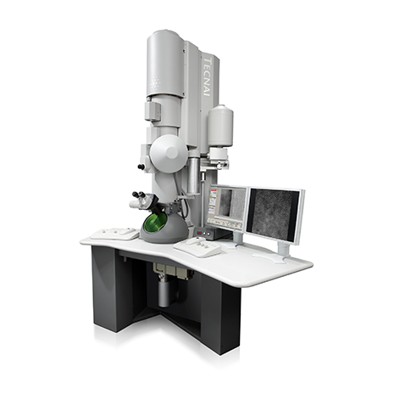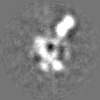+ Open data
Open data
- Basic information
Basic information
| Entry |  | |||||||||
|---|---|---|---|---|---|---|---|---|---|---|
| Title | sRT-V1 NFL trimer in complex with 12CA5 Fab | |||||||||
 Map data Map data | main map | |||||||||
 Sample Sample |
| |||||||||
 Keywords Keywords | HIV Env / HA tag / NFL trimer / VIRAL PROTEIN-IMMUNE SYSTEM complex | |||||||||
| Biological species |   Human immunodeficiency virus 1 Human immunodeficiency virus 1 | |||||||||
| Method | single particle reconstruction / negative staining / Resolution: 25.0 Å | |||||||||
 Authors Authors | Lee W-H / Ozorowski G / Ward AB | |||||||||
| Funding support |  United States, 2 items United States, 2 items
| |||||||||
 Citation Citation |  Journal: Cell Rep / Year: 2025 Journal: Cell Rep / Year: 2025Title: Molecular parameters governing antibody FcγR signaling and effector functions in the context of HIV envelope. Authors: Michael V Bick / Eduard Puig / David Beauparlant / Rebecca Nedellec / Iszac Burton / Keihvan Ardaghi / Thea R Zalunardo / Raiza Bastidas / Xuduo Li / Javier Guenaga / Wen-Hsin Lee / Richard ...Authors: Michael V Bick / Eduard Puig / David Beauparlant / Rebecca Nedellec / Iszac Burton / Keihvan Ardaghi / Thea R Zalunardo / Raiza Bastidas / Xuduo Li / Javier Guenaga / Wen-Hsin Lee / Richard Wyatt / Wenwen Zhu / Max Crispin / Gabriel Ozorowski / Andrew B Ward / Dennis R Burton / Lars Hangartner /   Abstract: Antibody effector functions contribute to the immune response to pathogens and can influence the efficacy of antibodies as therapeutics. To date, however, there is limited information on the ...Antibody effector functions contribute to the immune response to pathogens and can influence the efficacy of antibodies as therapeutics. To date, however, there is limited information on the molecular parameters that govern fragment crystallizable (Fc) effector functions. In this study, using AI-assisted protein design, the influences of binding kinetics, epitope location, and stoichiometry of binding on cellular Fc effector functions were investigated using engineered HIV-1 envelope as a model antigen. For this antigen, stoichiometry of binding was found to be the primary molecular determinant of FcγRIIIa signaling, antibody-dependent cellular cytotoxicity, and antibody-dependent cellular phagocytosis, while epitope location and antibodybinding kinetics, at least in the ranges investigated, were of no substantial impact. These findings are of importance for informing the development of vaccination strategies against HIV-1 and, possibly, other viral pathogens. | |||||||||
| History |
|
- Structure visualization
Structure visualization
| Supplemental images |
|---|
- Downloads & links
Downloads & links
-EMDB archive
| Map data |  emd_42908.map.gz emd_42908.map.gz | 20.7 MB |  EMDB map data format EMDB map data format | |
|---|---|---|---|---|
| Header (meta data) |  emd-42908-v30.xml emd-42908-v30.xml emd-42908.xml emd-42908.xml | 13.3 KB 13.3 KB | Display Display |  EMDB header EMDB header |
| Images |  emd_42908.png emd_42908.png | 35.3 KB | ||
| Filedesc metadata |  emd-42908.cif.gz emd-42908.cif.gz | 4 KB | ||
| Others |  emd_42908_half_map_1.map.gz emd_42908_half_map_1.map.gz emd_42908_half_map_2.map.gz emd_42908_half_map_2.map.gz | 20.7 MB 20.7 MB | ||
| Archive directory |  http://ftp.pdbj.org/pub/emdb/structures/EMD-42908 http://ftp.pdbj.org/pub/emdb/structures/EMD-42908 ftp://ftp.pdbj.org/pub/emdb/structures/EMD-42908 ftp://ftp.pdbj.org/pub/emdb/structures/EMD-42908 | HTTPS FTP |
-Validation report
| Summary document |  emd_42908_validation.pdf.gz emd_42908_validation.pdf.gz | 600.6 KB | Display |  EMDB validaton report EMDB validaton report |
|---|---|---|---|---|
| Full document |  emd_42908_full_validation.pdf.gz emd_42908_full_validation.pdf.gz | 600.2 KB | Display | |
| Data in XML |  emd_42908_validation.xml.gz emd_42908_validation.xml.gz | 10.6 KB | Display | |
| Data in CIF |  emd_42908_validation.cif.gz emd_42908_validation.cif.gz | 12.4 KB | Display | |
| Arichive directory |  https://ftp.pdbj.org/pub/emdb/validation_reports/EMD-42908 https://ftp.pdbj.org/pub/emdb/validation_reports/EMD-42908 ftp://ftp.pdbj.org/pub/emdb/validation_reports/EMD-42908 ftp://ftp.pdbj.org/pub/emdb/validation_reports/EMD-42908 | HTTPS FTP |
-Related structure data
- Links
Links
| EMDB pages |  EMDB (EBI/PDBe) / EMDB (EBI/PDBe) /  EMDataResource EMDataResource |
|---|
- Map
Map
| File |  Download / File: emd_42908.map.gz / Format: CCP4 / Size: 27 MB / Type: IMAGE STORED AS FLOATING POINT NUMBER (4 BYTES) Download / File: emd_42908.map.gz / Format: CCP4 / Size: 27 MB / Type: IMAGE STORED AS FLOATING POINT NUMBER (4 BYTES) | ||||||||||||||||||||||||||||||||||||
|---|---|---|---|---|---|---|---|---|---|---|---|---|---|---|---|---|---|---|---|---|---|---|---|---|---|---|---|---|---|---|---|---|---|---|---|---|---|
| Annotation | main map | ||||||||||||||||||||||||||||||||||||
| Projections & slices | Image control
Images are generated by Spider. | ||||||||||||||||||||||||||||||||||||
| Voxel size | X=Y=Z: 1.68 Å | ||||||||||||||||||||||||||||||||||||
| Density |
| ||||||||||||||||||||||||||||||||||||
| Symmetry | Space group: 1 | ||||||||||||||||||||||||||||||||||||
| Details | EMDB XML:
|
-Supplemental data
-Half map: half map B
| File | emd_42908_half_map_1.map | ||||||||||||
|---|---|---|---|---|---|---|---|---|---|---|---|---|---|
| Annotation | half map B | ||||||||||||
| Projections & Slices |
| ||||||||||||
| Density Histograms |
-Half map: half map A
| File | emd_42908_half_map_2.map | ||||||||||||
|---|---|---|---|---|---|---|---|---|---|---|---|---|---|
| Annotation | half map A | ||||||||||||
| Projections & Slices |
| ||||||||||||
| Density Histograms |
- Sample components
Sample components
-Entire : sRT-V1 NFL trimer in complex with 12CA5 Fab
| Entire | Name: sRT-V1 NFL trimer in complex with 12CA5 Fab |
|---|---|
| Components |
|
-Supramolecule #1: sRT-V1 NFL trimer in complex with 12CA5 Fab
| Supramolecule | Name: sRT-V1 NFL trimer in complex with 12CA5 Fab / type: complex / ID: 1 / Parent: 0 |
|---|---|
| Source (natural) | Organism:   Human immunodeficiency virus 1 Human immunodeficiency virus 1 |
-Experimental details
-Structure determination
| Method | negative staining |
|---|---|
 Processing Processing | single particle reconstruction |
| Aggregation state | particle |
- Sample preparation
Sample preparation
| Concentration | 0.03 mg/mL |
|---|---|
| Buffer | pH: 7.4 |
| Staining | Type: NEGATIVE / Material: uranyl formate |
- Electron microscopy
Electron microscopy
| Microscope | FEI TECNAI F20 |
|---|---|
| Image recording | Film or detector model: TVIPS TEMCAM-F416 (4k x 4k) / Average electron dose: 25.0 e/Å2 |
| Electron beam | Acceleration voltage: 120 kV / Electron source:  FIELD EMISSION GUN FIELD EMISSION GUN |
| Electron optics | Illumination mode: FLOOD BEAM / Imaging mode: BRIGHT FIELD / Nominal defocus max: 2.0 µm / Nominal defocus min: 1.0 µm |
| Sample stage | Specimen holder model: SIDE ENTRY, EUCENTRIC |
| Experimental equipment |  Model: Tecnai F20 / Image courtesy: FEI Company |
- Image processing
Image processing
| Startup model | Type of model: EMDB MAP EMDB ID: Details: low pass filtered to 40 Angstrom |
|---|---|
| Final reconstruction | Applied symmetry - Point group: C1 (asymmetric) / Resolution.type: BY AUTHOR / Resolution: 25.0 Å / Resolution method: FSC 0.5 CUT-OFF / Software - Name: RELION (ver. 4) / Number images used: 15730 |
| Initial angle assignment | Type: MAXIMUM LIKELIHOOD |
| Final angle assignment | Type: MAXIMUM LIKELIHOOD |
 Movie
Movie Controller
Controller









 Z (Sec.)
Z (Sec.) Y (Row.)
Y (Row.) X (Col.)
X (Col.)





































